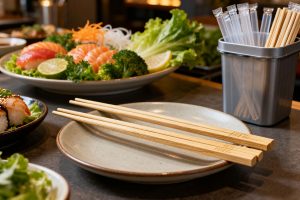Restaurants worldwide are switching to disposable chopsticks—but is this just a cost-saving move or a strategic hygiene solution?
Disposable chopsticks1 offer restaurants guaranteed hygiene, reduced labor costs, and compliance with international food safety standards1. Their plant-based materials (bamboo, wood, or crop fibers) eliminate cross-contamination risks while meeting strict GB/T 24398-2009 regulations2.
 Beyond the obvious convenience, let’s dissect why disposable chopsticks dominate modern food service—from cost structures to hidden regulatory advantages.
---
Beyond the obvious convenience, let’s dissect why disposable chopsticks dominate modern food service—from cost structures to hidden regulatory advantages.
---
What Are the Main Benefits of Using Disposable Chopsticks in Restaurants?
Imagine cutting dishwasher costs by 30% while boosting customer trust—disposable chopsticks deliver both. Restaurants benefit from zero cleaning expenses, consistent hygiene, and brand customization options (e.g., logo-stamped chopsticks)3. Bamboo variants decompose faster than plastic cutlery, aligning with sustainability goals4.
Key Advantages Breakdown:
- Hygiene Assurance
- Operational Efficiency
- Sustainability
Why Are Disposable Chopsticks More Cost-Effective for Restaurants?
Reusable chopsticks hide expenses—disposables slash costs transparently. Bulk purchases (e.g., 100pcs/bag at $0.01/unit) reduce per-use costs by 40% vs. washing reusable sets1. Suppliers like Bf1998 offer volume discounts for 50bag/ctn orders.
Cost Comparison:
- Reusable Chopsticks:
- Disposable Chopsticks:
What Are the Safety Standards for Disposable Chopsticks in Restaurants?
Not all disposable chopsticks are equal—food-safe compliance separates brands. GB/T 24398-2009 mandates toxin-free materials (no fluorescent whiteners/recycled fibers)3. International chains like McDonald’s require BRC-certified suppliers for allergen safety6.
Compliance Checklist:
- Material Safety:
- Quality Control:
Conclusion
Disposable chopsticks1 optimize hygiene, cost, and compliance—making them indispensable for modern restaurants.---
References
- 1. Explore the advantages of disposable chopsticks, including hygiene and cost savings, to understand their growing popularity in restaurants. ↩
- 2. GB/T 24398-2009 plant fiber standards. ↩
- 3. Material safety regulations (GB 19305, GB 9685). ↩
- 4. Sustainability certifications (FSC, BRC). ↩
- 5. GB 14934-1994 sterilization requirements. ↩
- 6. Bf1998’s multinational client compliance protocols. ↩







